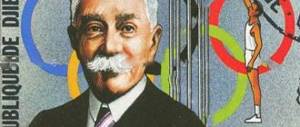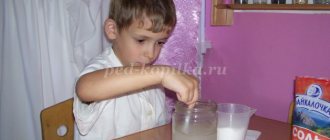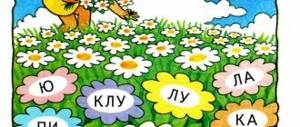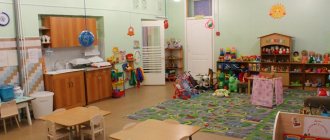Activities in the GPA for younger schoolchildren
Sports hour in the GPA for primary school
- Aligned... To the right!
Be equal! Attention! The teacher greets the children and gives a short goal setting for the lesson.
- To the left! Easy running!
The children, following the guide, run around the hall.
- Running with high hips!
- Run with straight legs!
- Hands on your belt!
The teacher, fit and energetic, in sports uniform, stands in the center of the hall and gives commands, paying attention to those children who perform the movements incorrectly, and praising those who are skillful.
This is how an exciting sports activity begins in the extended day group in 1st grade. The teacher pays a lot of attention to organizing physical education and health activities with children. Physical education and sports are the main means of strengthening their health. Extended hours of operation make it possible to engage in physical education with children every day. Taking these circumstances into account, from the first days of working with the group, the teacher introduces daily sports activities - a sports hour - as a mandatory part of the routine.
After a short warm-up, the main part of the sports hour begins, which takes place to the music. Children line up in three columns and stand at arm's length. The teacher turns on the tape recorder, where rhythmic music is recorded, stands facing the children and, together with them, without pauses, performs a series of exercises:
- Hands on the belt. Stand on your toes, on your heels. One two three four.
— Right leg to the side, on the heel, slightly squatted, placed.
- Same with the other leg. (Each exercise begins with a new piece of music.)
- Hands to shoulders. Turn your body to the left! Right!
- Hands on the belt. Let's start bending. Left! Right! Forward! Back! We bend the body!
-Exercise for legs.
- Jump higher!
- Running forward, backward, with turns.
In the process of conducting a set of exercises to music, the instructions given by the teacher are of great importance. They allow you to maintain the principle of the flow of movements and at the same time make adjustments to reduce errors of an aesthetic nature: insufficiently straight legs, poorly drawn socks, incorrect posture. After rhythmic gymnastics, the teacher gives the children time to calm down and organizes relaxation movements for this.
The next stage of the lesson is fun relay races and games, the sequence of which is thought out taking into account the degree of their intensity. So, if at first the teacher organizes competitions where you have to run a lot, jump, catch a ball, then at the end, to avoid overexcitement, there are games of a lower intensity: for observation, attention, precision of movements, orientation, ingenuity.
1. Children line up in two columns. The person standing in the column gets the ball first. Task: sit on it, ride to the wall and back, pass the ball to the next person on the team and stand last in a row. Whose team is faster?
2. Children stand in a circle and repeat the movements that the teacher makes. Condition of the game: carry out only those commands that are given with the word “class”.
- Class! Circle your head. Class! Tilts, jumps. If the word “class” is not spoken and the command is completed, the student leaves the circle.
During such sports competitions, the teacher acts as a judge. At the end of classes, he names the winning students or the winning team. When selecting games, the teacher takes into account the passage of program material in physical education lessons. This allows him to use many games and sports competitions to consolidate and improve skills in running, jumping, throwing and other movements that students learn in lessons.
The sports hour ends with formation of a column one at a time, a brief summary of the lesson, simple movements, the purpose of which is to bring the body into a calm state.
- To the right! Walking around the hall.
- Arms forward, up, to the sides.
- Hands on the belt. We breathe deeply through our nose.
- Let's go with our heads down.
— We slowly lift it back.
In the same order, children leave the gym for class. As you can see, the structure of a sports hour includes several stages:
1) preparatory: organized arrival of children to the sports ground (gym), formation, warm-up exercises as a means of preparing the body for subsequent more complex motor actions;
2) main part:
a) a set of gymnastic exercises to music;
b) competitive relay races and outdoor games of varying degrees of intensity;
3) final part: organized ending, formation, calm walking.
The clear organization of each lesson and the exciting nature of any stage of the lesson bring joy and pleasure to children. Frequent alternation of exercises of different nature eliminates long-term monotonous loads, develops all muscle groups, correct posture, strength, agility, and flexibility.
Sports hour is significantly different from physical education lessons. Its specific task is active recreation for children, aimed at relieving mental stress, reducing fatigue, increasing efficiency, and improving the physical development of schoolchildren. All of them are carried out in a more or less free form with elements of play, rhythm, and dance. Children get used to the established order of organizing this activity. Each student has his own permanent uniform for group classes.
An indispensable element of the sports hour is rhythmic gymnastics, which children really like. They perform a cycle of movements to the music with desire and diligence. This develops a sense of rhythm, improves coordination of movements, and improves mood. Music, with its enormous power of direct emotional impact, invigorates and captivates children. The main thing is to be able to arrange the exercises correctly, in a logical sequence, and choose a soundtrack.
The first phase of the lesson is light. These are varieties of walking in place, simple hand movements. It is important that the children “grab” the rhythm of the musical accompaniment.
The second phase is a chain of exercises that consistently develop joints and muscles (from top to bottom); exercises for the neck, shoulder joint, arms, torso and legs. The emotionality of the activity increases if balls, jump ropes, hoops, and gymnastic sticks are used. This phase ends with jumping and running.
In the third phase , it is advisable to introduce simple dance steps and movements into the lesson. At the same time, the teacher tries to give an emotional coloring to the movements, based on the nature of the music. Then it is possible to achieve the unity of music and movements.
In the fourth phase , the movements continue, but at a slow enough pace to gradually reduce the heart rate. This could include breathing and relaxation exercises. When selecting exercises, the characteristics of students are taken into account. Painstaking work - memorizing the complex. The guys do not immediately begin to move correctly to the music. Over time, the complex is updated. A sports hour, held in an extended day group, satisfies the body’s need for movement and serves to strengthen children’s health and well-being.
Summary Sports watch options
SPORTS WATCH OPTIONS
Option 1
Sports hour in the autumn period of the school year in the open air
1 part
- Line up on the playground one at a time. Message from the teacher about the content and other organizational aspects of active recreation.
- Game "Prohibited Movement". Form into a column one at a time. Walking is normal, with a transition of slow running around the site.
part 2
- Rearrangement in rows - teams. Relay race with a portable pin (mace, ball, flag, etc.) The game is repeated 3-4 times. Relay race with jumping on two legs (jumping and jumping out of laid out hoops or drawn circles). The game is repeated 3-4 times. A relay race with throwing a ball at a target (a hoop or a drawn circle). The game is repeated 3-4 times.
- Independent games for children using balls, skittles, hoops, jump ropes.
Part 3
- Formation into line from the starting line. The attendants are collecting sports equipment. Organizational care for school.
In this version, relay races and games in the general formation predominate.
Observations show that relay races are largely capable of disciplining children who are not sufficiently organized after the summer holidays, and, therefore, are more successful and effective than plot-based outdoor games.
Option 2
Sports hour in the autumn period of the school year in the open air
1 part
- Line up on the starting line one at a time. Organizational aspects.
- Walking in a column one at a time (regular, on toes, on heels, in a half-squat, in a squat with movement of the arms, legs, and torso).
- Running slowly, alternating with walking.
part 2
- Game "Tag in pairs". The game is repeated 3-4 times. The game is a relay race with long jumps and a push of two legs. Whose team will be the farthest in terms of total jumps? The game is repeated 3-4 times. The game is a relay race with balls being passed over the head. The game is repeated 2-3 times.
- Independent games for children using balls, skittles, hoops, jump ropes.
Part 3
- Rearrange students on the starting line into a line. Game "Comrade - Commander". The attendants are collecting sports equipment. The group simultaneously returns to school one by one in a column.
Option 3
Sports hour in the autumn period of the school year in the open air
1 part
- Formation on the starting line of the playing court. Organizational messages.
- Walking and slow running for up to 5 minutes
part 2
- Game "Everyone to their flags." Repeated 3-4 times. Game "Fishing Rod". The game is repeated 3-4 times. Game "Hunter and Ducks". The game is repeated 2-3 times.
- Independent games for children using balls, skittles, hoops, jump ropes.
Part 3
- Formation into line from the starting line. Game “What has changed?” Organizational care for school.
Option 4
Sports hour in the autumn period of the school year in the open air
1 part
- Formation on the starting line of the playing court. Organizational instructions for the teacher.
- Walking and slow running for up to 5 minutes
- General strengthening exercises in a circle.
part 2
- Formation in 3 columns - teams. Relay races with jumping rope. Game “Ball to the Average” (a game for accuracy and speed between teams).
- Independent games for children using balls, skittles, hoops, jump ropes. Sports entertainment for children.
Part 3
- Formation into line. The attendants are collecting sports equipment. Organizational care for school.
Option 5
Outdoor sports hour during the spring academic year
1 part
- Construction on the starting line. Organizational instructions for the teacher. Walking in a column to complete tasks.
- Slowly run around the site, transitioning to walking.
part 2
- Games “Wolf in the Moat”, “Mousetrap”.
- Independent games for children using balls, skittles, hoops, jump ropes. Jumping over long and short ropes. Game of "Classes".
Part 3
- Formation into line from the starting line. The attendants are collecting sports equipment. Organizational care for school.
Option 6
Sports hour in the autumn - spring period of the school year in the open air (using play structures)
1 part
- Alignment. Organizational instructions for the teacher. Walking is normal and includes additional movements of the arms, legs, and torso.
- Slow running.
part 2
- Alternately performing motor actions on structures: walking on a beam, working with a gymnastic stepladder, moving while hanging on your hands on a horizontal ladder, etc. Perform a complex of various motor actions 3-4 times.
- Independent games and sports entertainment: games with balls, jump ropes, hoops.
Part 3
- Alignment. Game "Prohibited Movement". Organizational care for school.
Option 7
Outdoor sports hour during the winter school year
1 part
- Line up on the starting line. Organizational instructions for the teacher.
- Walking and slow running.
part 2
- Games “Snowball”, “Best Builder” (teams compete, each team builds a snow fortification in a certain time).
- Game “Snowball on target” (competition between teams for the greatest number of hits on the target).
- Independent games for schoolchildren.
Part 3
- Formation into line from the starting line. Game “Form in a Line.” Organizational care for school.
Such content of the sports hour in the first days of winter is not accidental. It is consistent with the emotional mood of the schoolchildren caused by the first snow. Experience shows that younger schoolchildren will definitely try snow (making snowballs, snowmen, a fortress, etc.). Organized active recreation, combined with the mood and interest of children, as a rule, is successful and effective.
Option 8
Outdoor sports hour during the winter school year
1 part
- Formation in a line in the usual place (sleds and skis are placed in the indicated place).
- Walking on the site and running slowly.
part 2
- The game is a sled relay race with each other taking turns skating. A relay game on skis without poles (after the run, everyone passes the skis to the next one in their team).
- Independent games and sports entertainment. Alternate sledding and skiing.
Part 3
- General construction. Cleaning snow from skis, sleds and clothes. Organizational care for school.
Option 9
Outdoor sports hour during the winter school year
1 part
- Formation with skis in a line at a designated place on the site.
- Organizational instructions for the teacher. Putting on skis.
part 2
- Skiing in a column one after another on your own site, and, if possible, on a special ski track, in nearby parks, forests, etc.
Part 3
- General construction. Cleaning snow from skis, sleds and clothes. Organizational care for school.
Option 10
Sports hour during the winter period of the school year in the open air (if children have skates)
1 part
- Putting on skates indoors at school. Organized arrival of children to the school skating rink. General construction. Organizational instructions for the teacher.
part 2
- Skating. Game "Tag on Skates".
Part 3
- General construction. Organizational care for school.
Option 11
Indoor sports hour (allowed only in case of severe frost or rain)
1 part
- Organizational instructions for the teacher. General developmental exercises such as gymnastics before classes, standing near the desk.
part 2
- Organized games. Game “Vegetables, fruits, berries” (In rows). Game "What has changed?"
Part 3
- Game "Hot and cold".
Sports hour in the classroom is held only when it is not possible to conduct it indoors.
Methodological recommendations for outdoor activities
1. All classes are collective in nature.
2. Classes solve not only health-improving tasks, but also a certain range of educational tasks.
3. Each lesson requires the active participation of all students without exception, and for this it is necessary to determine its role for each.
4. The purpose of the lesson is communicated to all students. It should be clear to everyone.
5. Throughout the day, not a single lesson in the chosen activity should be repeated. Variety and novelty should be present in all activities.
6. When choosing the motor content of classes, you need to take into account the physical data of the children.
7. It is necessary to saturate the classes as much as possible with feasible activities. Use the time allocated to them economically and profitably.
8. The teacher must not lose control of the lesson; he needs to see and capture changes in the behavior and moods of the children.
9. When conducting classes, it is necessary to encourage the initiative and activity of schoolchildren.
10. At the end of the lesson, sum up its results and give your assessment of the children’s behavior.




